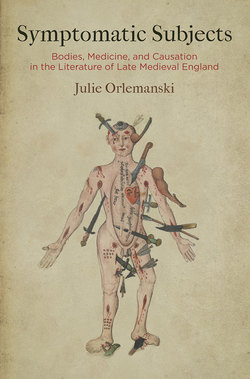Читать книгу Symptomatic Subjects - Julie Orlemanski - Страница 14
На сайте Литреса книга снята с продажи.
ОглавлениеChapter 3
Satire and Medical Materialism
“Guk guk, gud day, schir!” begins the rollicking medical satire “Sum Practysis of Medecyne” by the late fifteenth-century Scottish poet Robert Henryson.1 With these words, the poem’s narrator launches the boasting preface to a small collection of medical recipes he claims to have authored, a “sedull” addressed to his rival medical practitioner. “Guk guk” is a Middle Scots onomatopoeia imitating the cry of the cuckoo and, by extension, signifying nonsense.2 In invoking the cuckoo’s voice, Henryson casts the deviant medical language of his composition—its lexicon of materia medica and disease, of filth and excretions—under the sign of birdsong. The poem’s trill, however, is not that of the lyric nightingale or courtly tercelet but rather that of the bird known for its repetitive, nonsensical call—known, one might say, for its jargon.
The etymological roots of jargon lead back to Old French jargon, meaning the sound of birds, from the onomatopoeic base jarg-, garg-, related to la gargouille, the throat, and its “gargling.” The jargoilliant of birds points to “langage en général,” or the babble of speech stripped of any particular meaning.3 Jargon is the material of language, devoid of sense or reference. When words strike a listener or reader as mere jargon, it marks the threshold of a community of knowledge, where insiders are distinguished from outsiders, experts from novices. Words that have precise significance for some are for others so many empty phonemes rattling past. The “guk guk” that commences “Sum Practysis of Medecyne,” this chapter contends, refers to the peculiar musicality of medical language turned aside from its healing purpose and flaunting its own poetical energies—a perverse sonorousness that other literary works explore as well. Satire was one of two literary paths that the discourse of medicine traveled on its way into fictional narrative and poetry; the other, exemplary narrative, is discussed in the following chapter. Both satire and exempla provided to medieval thinkers opportunities to play with phisik and to turn its concepts, terms, and intellectual operations to literary ends.
What was the learned poet Robert Henryson up to in his nonsensical parody of medical textuality? What would its import have been for the poem’s fifteenth-century readers? So copious is the medical learning on display in another of Henryson’s works, The Testament of Cresseid (the topic of Chapter 6), that scholars have speculated that the poet might also have been a physician.4 While this remains mere conjecture (at odds with the sixteenth-century tradition that he was a schoolmaster in Dumerfermline5), “Sum Practysis of Medecyne” is evidence of his thorough familiarity with the conventions of medical discourse, a familiarity that he would have shared with many contemporary readers. By the second half of the fifteenth century, Scotland as well as England saw the growing textualization of medical learning in Latin, Gaelic, and Scots, and Henryson no doubt would have had passing familiarity with medicine’s role in English manuscript culture.6 The present chapter sets Henryson’s “Sum Practysis of Medecyne” within both the corpus of medical satire and the circumstances of late medieval phisik’s expanded accessibility. I do the same for Chaucer’s “Nun’s Priest’s Tale,” in which the hen Pertelote speaks a particularly unauthoritative version of phisik, and for the East Anglian miracle play the Croxton Play of the Sacrament, where the role of an itinerant quack doctor has long puzzled interpreters. These works were written in a period when medical discourse functioned as a novel textual laboratory for configuring words, bodies, and substances into new relations.7 The materiality of the physical body and the materiality of medical language were increasingly bound up together, and medical satire exaggerated and commented on that nexus.
